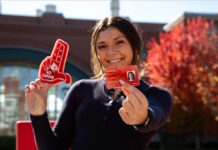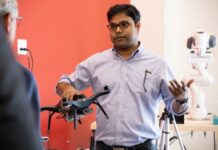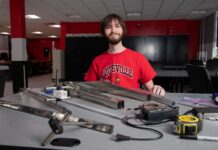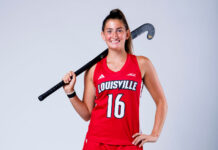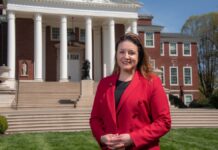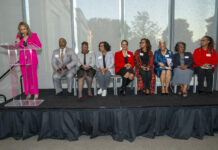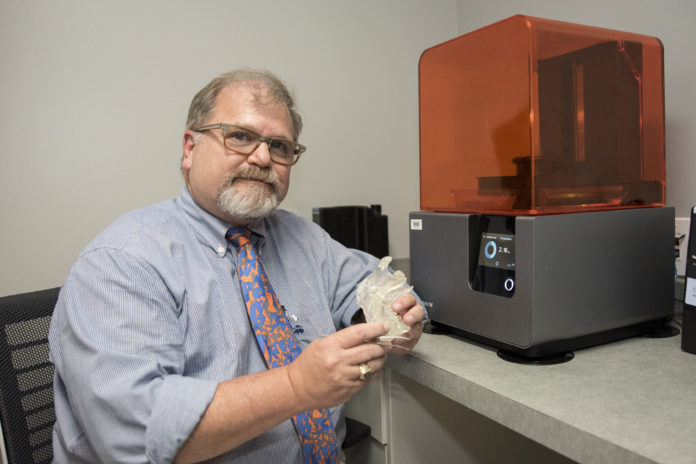
The University of Louisville is poised to become a premier center for 3D-based digital dental and medical care through the recent installation of several advanced technologies at the School of Dentistry.
Merging of the minds leads to 3D Virtual Print Lab
Located in the School of Dentistry’s Division of Radiology and Imaging Science (RIS) is a new 3D Virtual Print Lab capable of designing and manufacturing accurate life-size resin models of jaw bones, parts of faces and even entire skulls. These models help doctors plan surgeries and design surgical guides.
The lab is a joint initiative between RIS and the Department of Oral Health and Rehabilitation (OHR), in collaboration with UofL’s Additive Manufacturing Competency Center (AMCC) and the J.B. Speed School of Engineering. Researchers in these areas, along with biomedical engineers, are engaged in the evaluation of new printers and resins, as well as assessment of software applications for customized patient care.
“We have three Formlab2 printers in our lab, and access to a variety of 3D printers at UofL’s Rapid Prototyping Center, with an average turnaround time of just a few hours – depending on the complexity of the model or guide,” said Gerald T. Grant, DMD, MS, professor and interim chair of OHR. “These models and guides allow for better predictability of surgical procedures from facial reconstruction to dental implant placement.”
Grant says combining the expertise of engineers, prosthodontists and radiologists is “a recipe for innovation in the area of medical modeling and design.”
Under the leadership of Ed Tackett, director of UofL’s Additive Manufacturing Education and manager of the AMCC; Tim Gornet, manager of UofL’s Rapid Prototyping Center operations; and Grant, who also serves as president of the Advanced Digital Technologies Foundation, UofL is establishing a digital health care innovation center.
According to Grant, the innovation center will make UofL experts available to develop research and consultation for start-up and existing commercial companies; train dentists and physicians for use of in-house printers and medical models; and explore biocompatible resins using materials like hemp oils, soybean and synthetic bone.
Facial 3D photographic suite
In addition to the new 3D Virtual Print Lab, the School of Dentistry has added a facial imaging system – 3dMD Temporal Face, thanks, in part, to funding from Straumann.
Using multiple cameras in the 3D photographic suite, the technology captures 10 frames per second for several minutes at high resolution, and automatically generates a continuous moving 3D image. Grant says this unique system captures a patient’s facial movement – much like video except with still images, and can be measured and registered to other software.
“It will be the only system of its kind in Kentucky, and is applicable to use with
oral-maxillofacial surgery and reconstruction, ENT and neurosurgical analysis for pre- and post-surgical intervention and full mouth dental reconstructions,” Grant said.
Training the dentists of tomorrow through the digital dentistry clinic
A digital clinic for DMD students is scheduled to open in the spring 2018, complete with intra-oral scanners, computer-aided design and computer-aided manufacturing (CAD/CAM) and a milling station.
The digital dentistry clinic will give students greater access to practice and develop skills they already are learning through UofL’s digital dentistry curriculum. The intra-oral scanners have replaced traditional dental impressions needed for everything from crowns to orthodontic treatment. The CAD/CAM software will allow students to virtually design, form and shape a dental restoration. Students will then learn to use the milling station to create everything from crowns to veneers and fixed bridges.
Additionally, through work with prosthodontic faculty, students will have the opportunity to virtually plan and place dental implants. Students also will have access to SIMPLANT, an implant planning software needed for accurate and predictable implant treatment.
The new software allows the school to expand the implant curriculum for DMD students, and leverages imaging from cone beam computed tomography (CBCT), intra-oral scanners and laboratory scanners to guide implant planning from drilling to implant placement.
Sharing digital dental information enhances treatment
File sharing is critical to utilizing 3D imagery throughout a health care facility, and is the reason the School of Dentistry recently purchased INFINITT, a web-based 3D digital data system.
“INFINITT is the gold-standard for sharing 3D radiographic data between clinicians and between locations,” said William C. Scarfe, BDS, MS, professor and director, RIS, Department of Surgical and Hospital Dentistry. “The ability of this system to store 3D information, and interact with images at the chair-side will give our clinicians unsurpassed access, and provide our students an unsurpassed educational experience.”
Dental school radiologists worked with INFINITT engineers to build a system specific to the needs of the School of Dentistry, including a training template for students and residents on CBCT interpretation.

“While any dentist can buy a scanner and take an image, our graduates will be among the few who are trained to read the images for specific cases which will translate to improved diagnosis and efficient clinical outcome” said Bruno Azevedo, DDS, MS, assistant professor in RIS and lead clinician for the INFINITT project.
School-wide implementation of the file sharing software is underway, and endodontic residents are the first to pilot the school’s new educational imaging template.


